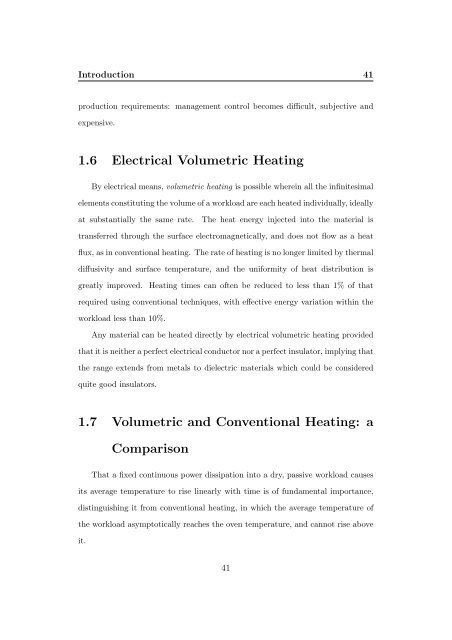Kinetic Analysis and Characterization of Epoxy Resins ... - FedOA
Kinetic Analysis and Characterization of Epoxy Resins ... - FedOA
Kinetic Analysis and Characterization of Epoxy Resins ... - FedOA
You also want an ePaper? Increase the reach of your titles
YUMPU automatically turns print PDFs into web optimized ePapers that Google loves.
Introduction 41<br />
production requirements: management control becomes difficult, subjective <strong>and</strong><br />
expensive.<br />
1.6 Electrical Volumetric Heating<br />
By electrical means, volumetric heating is possible wherein all the infinitesimal<br />
elements constituting the volume <strong>of</strong> a workload are each heated individually, ideally<br />
at substantially the same rate.<br />
The heat energy injected into the material is<br />
transferred through the surface electromagnetically, <strong>and</strong> does not flow as a heat<br />
flux, as in conventional heating. The rate <strong>of</strong> heating is no longer limited by thermal<br />
diffusivity <strong>and</strong> surface temperature, <strong>and</strong> the uniformity <strong>of</strong> heat distribution is<br />
greatly improved.<br />
Heating times can <strong>of</strong>ten be reduced to less than 1% <strong>of</strong> that<br />
required using conventional techniques, with effective energy variation within the<br />
workload less than 10%.<br />
Any material can be heated directly by electrical volumetric heating provided<br />
that it is neither a perfect electrical conductor nor a perfect insulator, implying that<br />
the range extends from metals to dielectric materials which could be considered<br />
quite good insulators.<br />
1.7 Volumetric <strong>and</strong> Conventional Heating: a<br />
Comparison<br />
That a fixed continuous power dissipation into a dry, passive workload causes<br />
its average temperature to rise linearly with time is <strong>of</strong> fundamental importance,<br />
distinguishing it from conventional heating, in which the average temperature <strong>of</strong><br />
the workload asymptotically reaches the oven temperature, <strong>and</strong> cannot rise above<br />
it.<br />
41
















